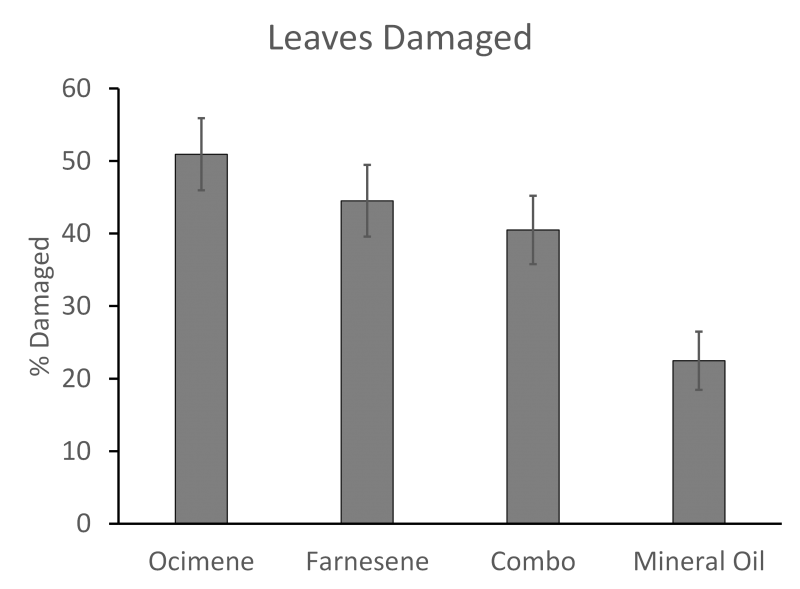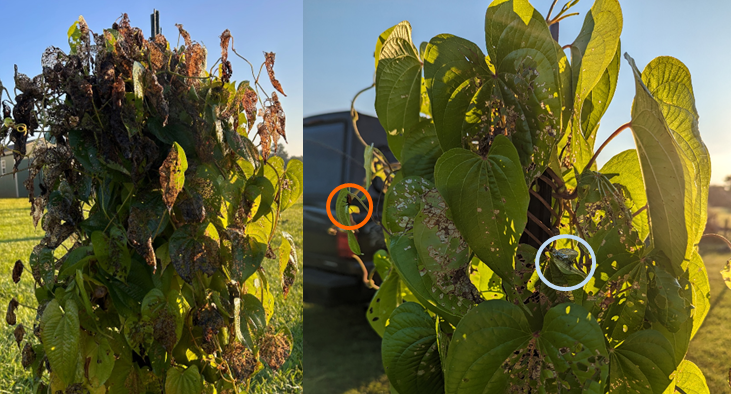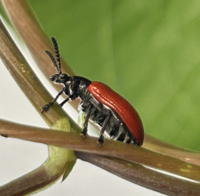Jessica Griesheimer, PhD Student, Xavier Martini, Entomology Specialist, North Florida Research and Education Center, Quincy
Air Potato Vine, Dioscorea bulbifera, is a perennial invasive vine found throughout the Southeastern United States. Infestations are commonly found in Florida, Georgia, Alabama, Mississippi, Louisiana, Texas, Hawaii, and Puerto Rico. Air potato is native to tropical Asia and was initially introduced into Florida in 1905. Since then, air potato escaped cultivation and has been observed to grow at a rate of 8 inches a day up into forest canopies, obscuring sunlight to other plants, and covering forest floors. Air potato negatively impacts wildlife dependent on native vegetation for forage, nesting, and cover. The vine primarily reproduces asexually through aerial bulbils that drop to the ground during the fall that can sprout into new plants the following spring. Additionally, mature underground tubers re-sprout yearly. A biological control agent, the air potato leaf feeding beetle, Liloceris cheni was released into Florida in 2011 and Louisiana in 2016 to help combat the spread of air potato (Fig. 1). Recently, a new biological control agent, Lilioceis egena (air potato bulbil feeding beetle), was approved for use in the United States and has been released to aid in the control of air potato. Both insects are highly host specific and will only feed on air potato.

Figure 2 Percentage of leaves damaged on field trial plants depending on their lure components. Combo lures were created from both ocimene and farnesene.
–
We investigated the behavior of the air potato leaf feeding beetle towards its host plant, air potato. In laboratory settings, we found that the beetle was strongly attracted to air potato plants that have received damage from other beetles at either the larval or adult stages. We then investigated the different volatile compounds released by the plant to better understand which ones may be attractive to the leaf feeding beetles. We followed this with an outdoor field trial to test the attraction of air potato leaf feeding beetles to certain volatiles released by the plant when it was damaged by the beetles. We found plants lured with chemically enhanced lures (β-ocimene, α-farnesene, and combination of both) were more likely to receive damage compared to lures without added chemicals (mineral oil) (Fig. 2). These research studies indicate the lure can be used by land managers in forestry and prairie land operations to reduce their reliance on costly and environmentally detrimental herbicidal sprays (Fig. 3).

Figure 3 (Left) Air potato field plants damaged by air potato leaf feeding larvae and adult beetles. (Right) Lured plant; Lure is circled in blue and attracted air potato beetle is circled in orange. Credit: Xavier Martini & Jessica Griesheimer, UF/IFAS
–
Owners of forests or pastures in North Florida are likely to face air potato infestation. Current recommendations for control of air potato include mechanical removal of aerial bulbils on sight (at any size) and to freeze them in plastic bags until they can be squished inside the bag indicating they are not longer able to sprout. It is also advised to pull vines and freeze them prior to discarding them. Herbicidal sprays do not combat the spread of air potato well. While the green vine portion of the plant will die back, the underground tuber is protected and will re-sprout. Aerial bulbils are also not negatively affected by herbicidal sprays and will still sprout. Current biological control recommendations are to use air potato leaf feeding beetle and air potato bulbil feeding beetles. Laraval feeding of both species causes high amounts of damage to air potato, often leading to heavy die back. If you suspect you have air potato, please contact your local extension agent to receive more information on how to receive biological control agents.
- Pepper Weevil is a True Menace to Pepper Production - October 3, 2025
- Sap Beetles are Not a Cause of Concern for Citrus but Katydids Are - October 4, 2024
- The Importance of Pollination for Seedless Watermelons and How to Enhance it - April 5, 2024

